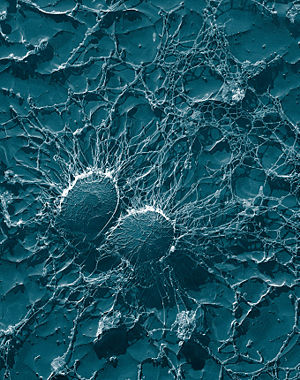Staphylococcus
Jump to navigation
Jump to search
Classification:
- Colour - S. aureus grey/yellow colonies, other two white.
- Coagulase - S. aureus has a coagulase enzyme, which forms clots in plasma.
- DNAase - S. aureus has this enzyme, others don't.
- Protein A - S. aureus has this cell wall antigen, others don't – so Protein A antibodies will only agglutinate S. aureus.
- Novobiocin sensitivity - To differentiate between the coagulase-negative types, S. epidermis and S. saprophyticus, only S. epidermis is sensitive to novobiocin.
S. aureus
About
- Common human commensal, found nasally in 30-50%.
- Coagulase hinders phagocytosis, as does the cell envelope.
- Protein A prevents binds to Fc component of antibodies, preventing complement activation.
Pathology
- Skin - boils, wound infections
- Respiratory – pneumonia, lung abscesses, worsening of chronic lung disease
Treatment
- 1st generation: flucloxacillin
- MRSA generation: vancomycin (glycopeptide)
- Van resistant generation: you will probably die.
S. epidermidis
About
- Common human commensal, found on skin in 30-50%.
- Very good at sticking to artificial surfaces, such as fake heart valves, hips, catheters and central venous lines; through production in some strains of a slime layer (glycocalyx)
Pathology
- UTIs, especially in catheterised patients.
- Bacteraemia, most common bacteria found in blood cultures.
Treatment
- They are similar to aureus, in that they have widespread resistance. Sadly, treatment often needs vancomycin.
S. saprophyticus
About
- Commonly causes UTIs in sexually active young women, sometimes leading to cystitis with haematuria (honeymoon cystitis)
